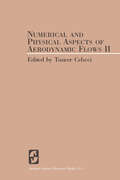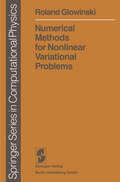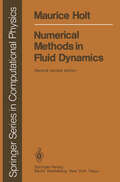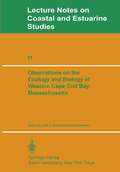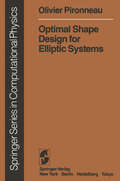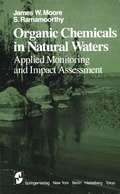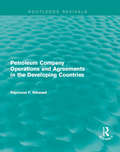- Table View
- List View
Mineral Processing in Developing Countries: A Discussion of Economic, Technical and Structural Factors
by United NationsThe Morphostructure of the Atlantic Ocean Floor: Its Development in the Meso-Cenozoic (International Astronomical Union Transactions #19A)
by V.M. LitvinThe study of the topography and structure of the ocean floor is one of the most important stages in ascertaining the geological structure and history of development of the Earth's oceanic crust. This, in its turn, provides a means for purposeful, scientifically-substantiated prospecting, exploration and development of the mineral resources of the ocean. The Atlantic Ocean has been geologically and geophysically studied to a great extent and many years of investigating its floor have revealed the laws governing the structure of the major forms of its submarine relief (e. g. , the continental shelf, the continental slope, the transition zones, the ocean bed, and the Mid-Oceanic Ridge). The basic features of the Earth's oceanic crust structure, anomalous geophysical fields, and the thickness and structure of its sedimentary cover have also been studied. Based on the investigations of the Atlantic Ocean floor and its surrounding continents, the presently prevalent concept of new global tectonics has appeared. A great number of works devoted to the results of geomorphological, geolog ical, and geophysical studies of the Atlantic Ocean floor have appeared. In the U. S. S. R. , such summarizing works as The Geomorphology of the Atlantic Ocean Floor [34], Types of Bottom Sediments of the Atlantic Ocean [24], The Geology of the Atlantic Ocean [38], and, somewhat earlier, Geophysical Studies of the Earth's Crust Structure in the Atlantic Ocean [13], have been published.
Multiphase Migration of Organic Compounds in a Porous Medium: A Mathematical Model (Lecture Notes in Engineering #8)
by Linda M. AbriolaGroundwater has long been one of the world's most important resources. It accounts for approximately 96% of all fresh water in the United States and supplies more than 50% of the population with potable water. Historically, this water source has generally been regarded as pristine. However, in recent years, contamination of ground water by industrial products has become a problem of growing concern. During the past four decades, the variety and quantity of organic chemicals produced in the U. S. has steadily increased. Currently, more than 40,000 different organic compounds are being manufactured, trans ported, used and eventually disposed of in the environment (Wilson, et !l (1981». Production and consumption of petroleum products has also risen in this same time period. Many of these industrial compounds are highly toxic and slightly water soluble. Thus, they pose a poten tial threat to large volumes of groundwater if they are somehow intro duced into the subsurface. Increased production of chemicals implies the increased risk of accidental spills or leakage to the soil, and indeed, the literature abounds with contamination case histories. 2 Incidences of petroleum contamination of groundwater have been documented by many authors. For example, see: Schwi11e (1967); Toms (1971); Guenther (1972); McKee, et!l (1912); Williams and Wilder (1971); Van100cke, et ~]-
Natural Disasters: Acts of God or Acts of Man? (Routledge Revivals)
by Anders Wijkman Lloyd TimberlakeOriginally published in 1984 Natural Disasters shows how misleading the term “natural disaster” can be. Forces of nature such as earthquakes, cyclones and extreme variations in weather can trigger disasters, but in many Third World countries it is environmental degradation, poverty and rapid population growth which turn a natural hazard into major disaster. This book questions whether the rich nations’ usual response to disaster – fast, short-lived emergency assistance – is any longer adequate. Today, most major disasters are “development” gone wrong, development which puts millions of poor people on the margins of existence. Disaster relief alone is like bandaging a rapidly growing wound. The appropriate response must include an element of true development – development which reduces rather than increases vulnerability to disasters.
Natural Disasters: Acts of God or Acts of Man? (Routledge Revivals)
by Anders Wijkman Lloyd TimberlakeOriginally published in 1984 Natural Disasters shows how misleading the term “natural disaster” can be. Forces of nature such as earthquakes, cyclones and extreme variations in weather can trigger disasters, but in many Third World countries it is environmental degradation, poverty and rapid population growth which turn a natural hazard into major disaster. This book questions whether the rich nations’ usual response to disaster – fast, short-lived emergency assistance – is any longer adequate. Today, most major disasters are “development” gone wrong, development which puts millions of poor people on the margins of existence. Disaster relief alone is like bandaging a rapidly growing wound. The appropriate response must include an element of true development – development which reduces rather than increases vulnerability to disasters.
The Natural Environment and the Biogeochemical Cycles (The Handbook of Environmental Chemistry #1 / 1C)
by G. G. ChoudhryEnvironmental Chemistry is a relatively young science. Interest in this subject, however, is growing very rapidly and, although no agreement has been reached as yet ab out the exact content and limits of this interdisciplinary discipline, there appears to be increasing interest in seeing environmental topics which are based on chemistry embodied in this subject. One of the first objectives of Environmental Chemistry must be the study of the environment and of natural chemical processes which occur in the environment. A major purpose of this series on Environmental Chemistry, therefore, is to present a reasonably uniform view of various aspects of the chemistry of the environment and chemical reactions occurring in the environment. The industrial activities of man have given a new dimension to Environmental Chemistry. We have now synthesized and described over five million chemical compounds and chemical industry produces about hundred and fifty million tons of synthetic chemicals annually. We ship billions of tons of oil per year and through mining operations and other geophysical modifications, large quantities of inorganic and organic materials are released from their natural deposits. Cities and metropolitan areas of up to 15 million inhabitants produce large quantities of waste in relatively small and confined areas. Much of the chemical products and was te products of modern society are released into the environment either during production, storage, transport, use or ultimate disposal. These released materials participate in natural cyc1es and reactions and frequently lead to interference and disturbance of natural systems.
Nature's Ideological Landscape: A Literary and Geographic Perspective on its Development and Preservation on Denmark's Jutland Heath (Routledge Revivals)
by Kenneth OlwigOriginally published in 1984 Nature’s Ideological Language examines the common ideological roots of environmental reclamation and nature preservation. In the general context of European, British and American historical experience, the Jutland heaths of Denmark are taken as a concrete example for a general critique of European and American policy concerning the use of landscape. Two sets of contradictions are highlighted: ideological and practical between development and preservation; and those between scientific, historical aesthetic and recreational motivation for preservation. The book is based on a study of the Jutland heath from 1750 to the present, focusing on the Danish perception of the area as expressed in literary art and in economic journals, topographies and government reports. Against this background, the development of the modern conception of nature is traced and its ideological implications and planning consequences discussed. As a study of humanistic geography, this book will be of interest to geographers, conservationists and planners.
Nature's Ideological Landscape: A Literary and Geographic Perspective on its Development and Preservation on Denmark's Jutland Heath (Routledge Revivals)
by Kenneth OlwigOriginally published in 1984 Nature’s Ideological Language examines the common ideological roots of environmental reclamation and nature preservation. In the general context of European, British and American historical experience, the Jutland heaths of Denmark are taken as a concrete example for a general critique of European and American policy concerning the use of landscape. Two sets of contradictions are highlighted: ideological and practical between development and preservation; and those between scientific, historical aesthetic and recreational motivation for preservation. The book is based on a study of the Jutland heath from 1750 to the present, focusing on the Danish perception of the area as expressed in literary art and in economic journals, topographies and government reports. Against this background, the development of the modern conception of nature is traced and its ideological implications and planning consequences discussed. As a study of humanistic geography, this book will be of interest to geographers, conservationists and planners.
Noise-Induced Transitions: Theory and Applications in Physics, Chemistry, and Biology (Springer Series in Synergetics #15)
by W. Horsthemke R. LefeverThe study of phase transitions is among the most fascinating fields in physics. Originally limited to transition phenomena in equilibrium systems, this field has outgrown its classical confines during the last two decades. The behavior of far from equilibrium systems has received more and more attention and has been an extremely active and productive subject of research for physicists, chemists and biologists. Their studies have brought about a more unified vision of the laws which govern self-organization processes of physico-chemical and biological sys tems. A major achievement has been the extension of the notion of phase transi tion to instabilities which occur only in open nonlinear systems. The notion of phase transition has been proven fruitful in apphcation to nonequilibrium ins- bihties known for about eight decades, like certain hydrodynamic instabilities, as well as in the case of the more recently discovered instabilities in quantum optical systems such as the laser, in chemical systems such as the Belousov-Zhabotinskii reaction and in biological systems. Even outside the realm of natural sciences, this notion is now used in economics and sociology. In this monograph we show that the notion of phase transition can be extend ed even further. It apphes also to a new class of transition phenomena which occur only in nonequilibrium systems subjected to a randomly fluctuating en vironment.
Non-Equilibrium Dynamics in Chemical Systems: Proceedings of the International Symposium, Bordeaux, France, September 3–7, 1984 (Springer Series in Synergetics #27)
by C. Vidal A. PacaultNonequilibrium Cooperative Phenomena in Physics and Related Fields (Nato Science Series B: #116)
by M. G. VelardeThis volume contains the lectures and invited seminars pre sented at the NATO Advanced Study Institute on NON-EQUILIBRIUM COOPERATIVE PHENOMENA IN PHYSICS AND RELATED FIELDS that was held at EL ESCORIAL (MADRID), SPAIN, on August 1-11, 1983. Most nonlinear problems in dissipative systems, i . e . , most mathematical models in SYNERGETICS are highly trans disciplinary in practice and the list of lecturers and participants at the ASI reflects this di versi ty both in background and interest. The presentation of the material fell into two main categories: tutopia~ Zectures on some basic ideas and methods, both experimental and theoretical, intended to lay a common base for all participants, and a series of more specific lectures and seminars, serving the purpose of exemplying selected but typical applications in their current state of development. Topics were chosen for their basic interest as well as for their potential for applications (laser, hydrodynamics, liquid crystals, EHD, combustion, thermoelasticity, etc. ). We had more seminars and some of the oral presentations were supported or complemented with 16 mm films and on occasion with experimental demonstrations including a special seminar, a social one on broken symmetries in Art and Music. There is here no record of these non-standard acti vi ties. We had, indeed, quite a heavy load for which I was fully responsible. However, the reader and, above all, the participants at the ASI ought to be aware of the fact that in Spain, with.
Numerical and Physical Aspects of Aerodynamic Flows II
by T. CebeciThe Second Symposium on Numerical and Physical Aspects of Aerodynamic Flows was held at California State University, Long Beach, from 17 to 20 January 1983. Forty-eight papers were presented, including Keynote Lec tures by A. M. 0. Smith and J. N. Nielsen, in ten technical sessions which were supplemented and complemented by two Open Forum Sessions, involving a further sixteen technical presentations and a Panel Discussion on the "Identification of priorities for the development of calculation methods for aerodynamic bodies. " The Symposium was attended by 120 research workers from nine countries and, as in the First Symposium, provided a basis for research workers to communicate, to assess the present status of the subject and to formulate priorities for the future. In contrast to the First Symposium, the papers and discussion were focused more clearly on the subject of flows involving the interaction between viscous and inviscid regions and the calculation of pressure, velocity and temperature characteristics as a function of geometry, angle of attack and Mach number. Rather more than half the papers were concerned with two-dimensional configurations and the remainder with wings, missiles and ships. This volume presents a selection of the papers concerned with two dimensional flows and a review article specially prepared to provide essen tial background information and link the topics of the individual papers.
Numerical Methods for Nonlinear Variational Problems (Scientific Computation)
by Roland GlowinskiThis book describes the mathematical background and reviews the techniques for solving problems, including those that require large computations such as transonic flows for compressible fluids and the Navier-Stokes equations for incompressible viscous fluids. Finite element approximations and non-linear relaxation, and nonlinear least square methods are all covered in detail, as are many applications. This volume is a classic in a long-awaited softcover re-edition.
Numerical Methods in Fluid Dynamics (Scientific Computation)
by Maurice HoltFrom the reviews of the first edition: "This book is directed to graduate students and research workers interested in the numerical solution of problems of fluid dynamics, primarily those arising in high speed flow. ...The book is well arranged, logically presented and well illustrated. It contains several FORTRAN programms with which students could experiment ... It is a practical book, with emphasis on methods and their implementation. It is an excellent text for the fruitful research area it covers, and is highly recommended". Journal of Fluid Mechanics #1 From the reviews of the second edition: "The arrangement of chapters in the book remains practically the same as that in the first editon (1977), except for the inclusion of Glimm's method ... This book is higly recommended for both graduate students and researchers." Applied Mechanics Reviews #1
Observations on the Ecology and Biology of Western Cape Cod Bay, Massachusetts (Coastal and Estuarine Studies #11)
by J. D. Davis D. MerrimanDevelopment and publication of this monograph are the result of the joint efforts of Boston Edison Company and the Pilgrim Administrative Technical Committee (PATC). The PATC is an advisory committee established in 1969 to ensure that Pilgrim Station marine studies have the benefit of Qualified scientific and technical advice and are responsive to regulatory agency concerns. The PATC is composed of representatives from the following: Massachusetts Division of Marine Fisheries Massachusetts Division of Water Pollution Control National Marine Fisheries Service (NOAA) U. S. Environmental Protection Agency U. S. Fish and Wildlife Service (Dept. of the Interior) University of Massachusetts Boston Edison Company The PATC formed the Pi 1 grim Stati on Marine Ecology Monograph Subcommi ttee to guide Monograph funding efforts, oversee technical aspects of preparation, consi der editor sel ecti on, advi se the edi tors and authors, and resol ve possi bl e conflicts. Members of the Subcommittee were as follows: W. Leigh Bridges - Mass. Div. Marine Fisheries (Subcommittee Chairman) Robert Lawton - Mass. Div. of Marine Fisheries Joseph Pelczarski - Mass. Office Coastal Zone Management Michael Ross - University of Massachusetts Robert Leger - U. S. Environmental Protection Agency Thomas Horst - Stone & Webster Engineering Corporation Richard Toner - Marine Research, Inc. Robert Anderson - Boston Edison Company Lewis Scotton - Boston Edison Company This publication was made possible by grants from: Massachusetts Office of Coastal Zone Management Boston Edison Company Massachusetts Division of Marine Fisheries U. S.
Optimal Shape Design for Elliptic Systems (Scientific Computation)
by O. PironneauThe study of optimal shape design can be arrived at by asking the following question: "What is the best shape for a physical system?" This book is an applications-oriented study of such physical systems; in particular, those which can be described by an elliptic partial differential equation and where the shape is found by the minimum of a single criterion function. There are many problems of this type in high-technology industries. In fact, most numerical simulations of physical systems are solved not to gain better understanding of the phenomena but to obtain better control and design. Problems of this type are described in Chapter 2. Traditionally, optimal shape design has been treated as a branch of the calculus of variations and more specifically of optimal control. This subject interfaces with no less than four fields: optimization, optimal control, partial differential equations (PDEs), and their numerical solutions-this is the most difficult aspect of the subject. Each of these fields is reviewed briefly: PDEs (Chapter 1), optimization (Chapter 4), optimal control (Chapter 5), and numerical methods (Chapters 1 and 4).
Organic Chemicals in Natural Waters: Applied Monitoring and Impact Assessment (Springer Series on Environmental Management)
by J.W. Moore S. RamamoorthyThis series is dedicated to serving the growing community of scholars and practitioners concerned with the principles and applications of environ mental management. Each volume is a thorough treatment of a specific topic of importance for proper management practices. A fundamental objective of these books is to help the reader discern and implement man's stewardship of our environment and the world's renewable re sources. For we must strive to understand the relationship between man and nature, act to bring harmony to it, and nurture an environment that is both stable and productive. These objectives have often eluded us because the pursuit of other individual and societal goals has diverted us from a course of living in balance with the environment. At times, therefore, the environmental manager may have to exert restrictive control, which is usually best applied to man, not nature. Attempts to alter or harness nature have often failed or backfired, as exemplified by the results of imprudent use of herbicides, fertilizers, water, and other agents. Each book in this series will shed light on the fundamental and applied aspects of environmental management. It is hoped that each will help solve a practical and serious environmental problem.
Palaeoecology of Africa, volume 16 (Palaeoecology Of Africa Ser.)
by J. A. Coetzee E. M. Van Zinderen BakkerThis text gives an environmental history of Africa, concentrating on 30 contributions on oceans and ocean margins, the Sahara and West Africa.
Palaeoecology of Africa, volume 16 (Palaeoecology Of Africa Ser.)
by J. A. Coetzee E. M. Van Zinderen Bakker SRThis text gives an environmental history of Africa, concentrating on 30 contributions on oceans and ocean margins, the Sahara and West Africa.
Patterns of Change in Earth Evolution: Report of the Dahlem Workshop on Patterns of Change in Earth Evolution Berlin 1983, May 1–6 (Dahlem Workshop Report #5)
by H. D. Holland A. F. Trendall H. Füchtbauer D. P. McKenzie D. M. Raup E. R. Oxburgh A. Seilacher G. J. Wasserburg W. H. Berger K. S. Deffeyes K. Padian F. M. Richter A. B. Thompson3 of the experience of the last few generations. The group of happily unexperienced events includes large bolide impacts with the Earth. The evidence for the occurrence of such impacts at intervals of some tens of millions of years is quite convincing, and Lyell stands admonished by Hamlet: "There are more things in heaven and earth, Horatio, than are dreamt of in your philosophy. " The role of bolide impacts on the history of life during other portions of the Phanerozoic Eon is less clear (see Raup and Fischer, both this volume), and catastrophic changes unrelated to extraterrestrial processes may have been important (see Holser, this volume). Changes in the later Precambrian biota are still difficult to interpret, in part because the preservation of soft-bodied animals from this period of Earth history is so unusual (see Seilacher, this volume). During the past billion years or so, bolide impacts have exerted a significant effect on the Earth's surface and its inhabitants, but not on its interior. The 3800 Ma rocks at Isua in West Greenland are the oldest terrestrial rocks that are currently available for inspection (see Dymek, this volume). They contain abundant evidence for the operation of chemical and physical processes that are similar to those of the present day. This situation could not have prevailed during the entire 700 Ma preceding the formation of the Isua rocks.
Petroleum Company Operations and Agreements in the Developing Countries (Routledge Revivals)
by Raymond F. MikesellOriginally published in 1984, this study focuses on petroleum agreements between non-OPEC LDCs with oil-importing LDCs and how issues such as high oil prices affect each country. The information presented in this study was drawn from interviews with petroleum officials in petroleum companies, petroleum ministries and unpublished documents such as contracts and focussing on case studies of countries such as Peru, Guatemala and Malaysia. This title will be of interest to students of environmental studies and economics.
Petroleum Company Operations and Agreements in the Developing Countries (Routledge Revivals)
by Raymond F. MikesellOriginally published in 1984, this study focuses on petroleum agreements between non-OPEC LDCs with oil-importing LDCs and how issues such as high oil prices affect each country. The information presented in this study was drawn from interviews with petroleum officials in petroleum companies, petroleum ministries and unpublished documents such as contracts and focussing on case studies of countries such as Peru, Guatemala and Malaysia. This title will be of interest to students of environmental studies and economics.
Petroleum Formation and Occurrence
by B.P. Tissot D.H. WelteCurrent and authoritative with many advanced concepts for petroleum geologists, geochemists, geophysicists, or engineers engaged in the search for or production of crude oil and natural gas, or interested in their habitats and the factors that control them, this book is an excellent reference. It is recommended without reservation. AAPG Bulletin.
Petroleum Geology of the North European Margin: Proceedings of the North European Margin Symposium (NEMS '83), organized by the Norwegian Petroleum Society and held at the Norwegian Institute of Technology (NTH) in Trondheim 9–11 May, 1983
by A. M. SpencerComplete Proceedings of the Symposium organised by the Norwegian Petroleum Society and held at Trondheim, Norway in 1983










